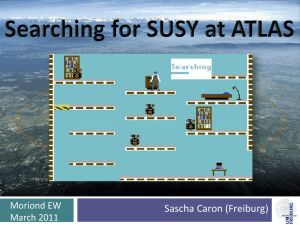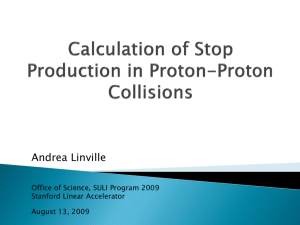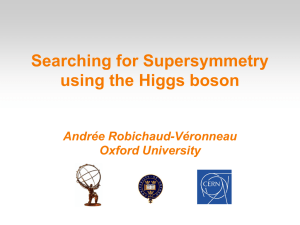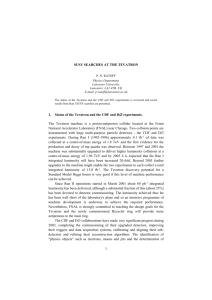Dark Matter and the LHC
advertisement
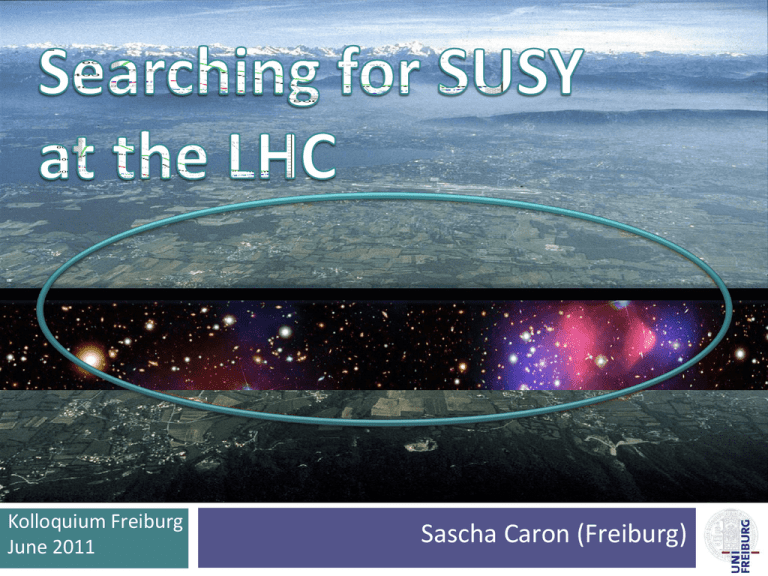
Kolloquium Freiburg June 2011 Sascha Caron (Freiburg) Outline 2 Beyond the Standard Model ? The first ATLAS (CMS) SUSY results What have we learned ? A Summary The Standard Model of Particle Physics 3 Is this picture correct? What is this object ? Important, but not part of this talk (soon enough data!) The Standard Model: Is this it ? 4 Dark Matter / Dark Energy is not explained by the Standard Model Why 3 (or 4) forces ? Why 3 families ? Why different fermion masses? …. Higgs mass suffers from unnatural fine-tuning due to quadratic quantum corrections (hierarchy or fine-tuning problem) Many other open questions (Gravity not included, where is the antimatter?,…) Some of these questions might be solved (or better understood) with LHC data Candidate Nr. 1 : Supersymmetry Most studied theory model + high LHC cross section big impact Today we concentrate on this area, i.e. low energy SUSY One physicist's schematic view of particle physics in the 21st century (Courtesy of Hitoshi Murayama) Candidate Nr. 1 : Supersymmetry 6 SUPERSYMMETRY (SUSY) is an extension of the Standard Model with a new symmetry between half-integer spin fermions and integer spin bosons New SUSY “shadow” particles predicted: - SUSY particles are not always the mass eigenstates (mixing) - The Higgs sector is modified/extended with SUSY No SUSY particles with the mass of the SM particles SUSY is a broken symmetry A new Quantum Number (R-parity) is added which forbids strong proton decay (Baryon and Lepton number violation) Candidate Nr. 1 : SUSY 7 Most studied new physics theory for several reasons : - “Easier QFT”: Fermion and Boson loops protect the Higgs mass at large energies (reduces “fine tuning”) if SUSY mass scale is not too large (LHC)! - SUSY is a broken symmetry and thus offers (with R-parity conservation) weakly interacting massive particles for Dark Matter with a mass of O(100) GeV - unification of 3 coupling constants at high energy in one point (GUT scale at 1016 GeV?), SUSY breaking connected to electroweak symmetry breaking ? Candidate Nr. 1 : SUSY 8 Most studied new physics theory for several reasons : - “Easier QFT”: Fermion and Boson loops protect the Higgs mass at large energiesImportant (reduces “fine tuning”) if SUSY mass scale is not too drawback: large (LHC)! SUSY has not been found yet - SUSY is a broken symmetry and thus offers (with R-parity conservation) weakly fine interacting massive particles for Dark some (small) tuning needed Matter with a already mass ofin O(100) GeV the model! - unification of 3 coupling constants at high energy in one point (GUT scale at 1016 GeV?), SUSY breaking connected to electroweak symmetry breaking ? SUSY particles (MSSM) 9 MSSM particle Zoo Models of SUSY breaking >100 parameters in MSSM SUSY breaking mechanisms generate masses The new colored particles are produced with a high rate by the strong force Sub-models with Less parameter: mSUGRA GMSB AMSB etc. SUSY or mSUGRA / CMSSM 10 Most studied scenario is the 5 parameter mSUGRA model M0: common boson mass at GUT scale M1/2: common fermion mass at GUT scale tan β: ratio of higgs vacuum expectation values A0: common GUT trilinear coupling μ : sign of Higgs potential parameter Most points give too much Dark Matter ! Large DM (LSP) annihilation cross section required by DM constraints Huge restriction of parameter space in restrictive models But if we are not in this restrictive model: No stringent constraint on allowed masses + we do not know exact susy breaking A-Funnel region at large tan beta SUSY and the LHC : Signal 11 If R-Parity is conserved then SUSY particles are pair produced q˜ g˜ LHC: Due to strong force dominant production of squarks and gluinos (if not too heavy) Cascade decay to lighter SUSY particles and finally the lightest SUSY particle (LSP) LSP Mass pattern in general SUSY unknown ! Searches need to be quite general and model-parameter-independent LHC is a proton-proton (and lead nuclei) collider with design centreof-mass energy of 14 TeV and an instantaneous luminosity of 1034 cm-2s-1 The LHC is operating 2010-2012 at 7 TeV centre-of-mass energy 12 and delivering an integrated luminosity of about 50 pb-1 in 2010 and > 1100 pb-1 in 2011 (delivered per experiment so far) with a peak luminosity of about 1.25 1033 cm-2s-1 CMS and 15*21 m 14500 tons 13 Huge silicon detector (pixel and strips) 4 Tesla solenoid Crystal EM calorimeter:σ(E)/E~3%/√E + 0.003 Brass and scintillator had. Calorimeter: (E)/E ~100%/E + 0.05 Muon Chambers: (p)/p <10% at 1TeV Level 1 + higher level trigger Resolutions might be measured in different experimental environments ATLAS 25*44 m 7000 tons Silicon detector (pixel and strips) and Transition Radiation Tracker (TRT) 2 Tesla solenoid + barrel and endcap toroid Em. calorimeter (PB+Lar) :σ(E)/E~10%/√E+0.007 Hadronic calorimeter (Iron Tile + Scint., Cu +Lar): (E)/E~50%/E+0.03 Muon Chambers (Drift Tubes): (p)/p <10% at 1TeV 3 level trigger system Both detectors operational at high efficiency 3 jets with pT of approximately 400 GeV, 120 GeV, 60 GeV and Etmiss of approximately 420 GeV MET and event display 14 Event found in signal region of jet+ Etmiss Analysis in 2010 data Searches presented today 15 Accepted/ Published ATLAS results with 2010 luminosity Supersymmetry: Jets + lepton + Etmiss Jets + Etmiss (2010 data published PRL, 2011 prelim.) (2010 data published PLB, 2011 prelim.) Jets + b-tag + Etmiss (accepted) Dilepton + Etmiss (accepted) e mu (accepted) Slow Moving Particle (accepted) … other channels in preparation Similar list of channels studied in CMS Exotics: 1st and 2nd generation Leptoquarks High mass dilepton resonances and contact interactions Dijet resonances W’ … Higgs: SM Higgs limits This talk concentrates on ATLAS results, CMS shown for comparison Analysis model - signal 16 Signal region Predict to see new physics at : -Large mass scale (masses beyond tevatron reach) - Large missing transverse momentum (neutralinos!) Signal region (QCD, W, Z, top) Analysis model - signal 17 Signal region Predict to see new physics at : -Large mass scale (masses beyond tevatron reach) - Large missing transverse momentum (neutralinos!) Background can be determined via Monte Carlo simulation of physics processes and a detailed detector simulation However the simulation needs to be validated Signal region (QCD, W, Z, top) Analysis model - background 18 Signal region Predict to see new physics at : -Large mass scale (masses beyond tevatron reach) - Large missing transverse momentum (neutralinos!) Before cuts (σ scales exp. with box size) W + jets background σ≈10400*3 pb QCD (real Et miss Top pair production σ≈160 pb ) (real Etmiss) Background Z neutrinos is irreducible σ>1000000 pb + mainly fake Etmiss due to mismeasurement Signal region (QCD, W, Z, top) σ≈1070*6 pb (real Etmiss) Analysis model - background 19 Signal region Predict to see new physics at : -Large mass scale (masses beyond tevatron reach) - Large missing transverse momentum (neutralinos!) After cuts (background size scales with box size linearly) W + jets background Top pair production σ≈10400*3 pb (real Etmiss σ≈160 pb (real Etmiss) ) QCD Background σ>1000000 pb + mainly fake Etmiss due to mismeasurement Signal region (QCD, W, Z, top) Z neutrinos is irreducible σ≈1070*6 (real Etmiss) Analysis model - control regions 20 W control region QCD control region Top control region Signal region Z control region (QCD, W, Z, top) - Measure number of events in control selections - Predict number of events in signal region via a fit to control regions - Important : Test model and transfer functions (e.g. by alternative control regions or methods) Jets + lepton + Etmiss 21 Expected to be less effected by potentially “dangerous” QCD background, main background W and top pairs Analysis cuts follow quite closely previous ATLAS MC studies (work between 2006-2009) 1 electron or muon with pT>20 GeV 3 jets with pT> 60,30,30 GeV Etmiss > 125 GeV and Etmiss > 0.25 * Meff Transverse mass > 100 GeV Meff > 500 GeV Definition of W and top control regions: 30< Etmiss < 80 GeV 40< transverse mass < 80 GeV Veto b-tag : W control region Apply b-tag : top pair control regions 3 Jets + lepton + Etmiss 22 First ATLAS SUSY paper arXiv:1102.2357 Jets + lepton + Etmiss 23 o o Fits to control regions predict the number of Top, W and QCD events in the signal region Several cross checks performed (e.g. tests with alternative control regions) Profile likelihood ratio test + toys Main result: Table and 95% CL Limits on Cross section * Acceptance *effi. Electron channel: Muon channel: Jets + lepton + Etmiss : 165 pb-1 Preliminary result with 2011 data 24 Signal region identical to 2010 analysis: Jets + lepton + Etmiss : 165 pb-1 Preliminary result with 2011 data 25 5 times more data, but new observed limit is slightly worse compared to 2010 data The signal regions A,B,C,D are inclusive Jets + Etmiss 26 Very simple model-independent classification of signal regions: Low and high mass dijets (squarks quark neutralino) Region C and D Trigger efficiency close to 1 for all signal and control regions 1200 1000 800 600 400 200 0 Region C gluinos pairs Low and high mass 3-jets (associated squark/gluino and gluino pair production): Squark mass Region A and B Region D Squark/gluino Region B Region A squark pairs 0 500 1000 Gluino mass 1500 Jets + Etmiss : Background evaluation 27 Main work: Typically 2-4 control region measurements or “data driven” methods performed for each background (and each signal region) Examples: QCD : control regions with inverted cuts e.g. δφ(jet,MET), determination without MC but smearing data with the measured detector response. Z+ jets: Zμμ, Zee and W control regions W+ jets: Wμν and Wev control regions, tau embedding Top pairs: Top control regions with or without lepton, and W embedding Jets + Etmiss : Results 28 Signal region A, B, C, D exclude non-SM process within acceptance*effi. of SUSY model-independent search Interpretation: Take the signal region with the largest expected sensitivity Show reach of the search for 2 examples Jets + Etmiss : Results 29 Simple MSSM Model with light 1st and 2nd gen. squarks , gluinos and a massless neutralino 1 sigma total experimental uncertainty band shown (shows roughly the 1 and 3 sigma exclusion) Exclusion reach not strongly sensitive to sign(mu), tan beta and A0 Jets + Etmiss : Results 30 Shows best mSUGRA fits to low energy data excluded (here arxiv 1102.4693, M0=75, M1/2=329 GeV) Jets + Etmiss : Results 31 Consider the signal region with the best expected upper limit. Automatically chosen by limit setting algorithm Jets + Etmiss : 165 pb-1 Preliminary result with 2011 data 32 -Only high mass (Meff>1000 GeV) region analyzed so far -Background fit to control regions (5*3 control regions, gamma+jets for Z+jets) - 4 jet channel has been added Jets + Etmiss : 165 pb-1 Preliminary result with 2011 data 33 In mSUGRA : Msquark = Mgluino > 950 GeV Improvement due to 4 jet channel Jets + Etmiss : 165 pb-1 34 Simplified MSSM : Msquark = Mgluino > 1025 GeV Preliminary result with 2011 data Other Interpretations possible ! 35 lepton + jets analysis Example: How can a theorist use these data ? Jets analysis Signal efficiency * acceptance provided for each signal region and analysis channel (see ATLAS public SUSY results webpage) Les Houches Accord SUSY steering files provided Validate your “local” setup Interpret the data with your favored model. or “simplified” model CMS 0 lepton channel 36 3 (independent) searches in the jets+MET channel: - “alpha_T” (Phys.Lett.B698:196-218,2011) - “Razor“ (prelimary result, see backup slides) - “HTMiss” (submitted to JHEP) CMS alpha_T 37 First LHC SUSY limit Basic selection quantity ETj2 is ET of less energetic jet MT is transverse mass of the dijet system Exploits that QCD dijet events are back to back with equal PT If > 2 jets, the jets are combined to form a di-jet system by minimizing the ET difference of the neighboring jets Randall /Tucker-Smith CMS alpha_T limits 38 CMS “HTMISS” 39 Strategy similar to ATLAS jets+MET calculated also only via p_T> 30 GeV jets Two signal regions: As in ATLAS background is estimated with several control selections, e.g. - QCD via jet resolution functions - Z background from via CMS limits in CMSSM/mSUGRA 40 Stable Massive Particle Search 41 Search for R-hadrons (stable hadrons including a stable gluino, stop or sbottom) Selection: Etmiss >40 GeV for triggering + track with pT > 50 GeV Two complementary subsystems used to measure SMPs 1. Tile sampling calorimeter iron+plastic scintillators, time resolution of 1-2 ns, calibrated with muons from Z decays 2. Pixel detector: dE\dx is measured with the charge loss (prop. to time over treshold) Background estimates and signal distributions for the pixel and tile mass measurements Stable Massive Particle Search Measure dE/dx to determine βγ via Bethe/Bloch formular for Pixel and beta of the tile calorimeter Transform these measurement into mass via M = p / βγ Background determined via random picking of momentum, tile, pixel information 42 Final signal regions defined by requiring cuts on both mass measurements No events after final selections New strongest limits limits on stable the masses of ATLAS search limits 43 Interpretations: What does this all mean ? 44 ? By how much do the ATLAS/CMS limits reduce the probability to allow low mass Supersymmetry to be the solution of the DM and hierarchy problem? What is the effect of the early mSUGRA results on direct DM experiments ? ATLAS jets and jets + 1 lepton papers are the most-cited 2010 ATLAS papers Dark Matter implications 45 Find consistent picture in the next decade ! Strong Implications for DM-proton detection when using constrained models (CMSSM, msugra,…) Shown is only 2010 data limit Note that big part of this region needs very large fine tuning Fine tuning after early LHC 46 Regions of mSUGRA Parameter space with minimal fine tuning (delta <100) Regions of minimal fine tuning and consistent with DM will only be excluded after LHC upgrade ! CMS Alpha_t ATLAS 0l+1l 2010 ATLAS 0l 2011 CMS 2010 Summary and Conclusion 47 SUSY Phase Space 300 700 1100 1500 2009 Summary and Conclusion 48 SUSY Phase Space 300 700 1100 1500 2010 data Summary and Conclusion 49 SUSY Phase Space 300 700 1100 1500 2011 data so far Summary and Conclusion 2011 data so far 50 SUSY Phase Space 300 700 1100 1500 The search has begun, the baseline analyses are in place ! mSUGRA: Msquark = Mgluino > 950 GeV (ATLAS) Expect sensitivity around 1.1 TeV for summer conferences Exploiting full relevant SUSY phase space needs 14 TeV & ATLAS upgrade 51 EXTRA SLIDES 0 lepton background determination 52 Non gaussian tail of the jet response function R_2 = (p_T.(p_T+p_T^miss))/|p_T + p_T^miss|. Events in which requirements have been used to associate the source of the P_T^miss with only one of the jets. The Gaussian core of the jet response function is removed by the selection requirements on E_T^miss. For each p_T bin the tails at low R_2 are subsequently used, together with the central Gaussian part of the response function (measured separately), and a set of low-E_T^miss seed events to form the fully data-driven QCD determination No SUSY ? Or different SUSY ? 53 Many good reasons for physics beyond the Standard Model at LHC energies Two important future LHC research topics: 1. Is SUSY realized ? - Final conclusion only after LHC upgrade 2. Is there something else ? - General search for new phenomena at ATLAS 3. Is the Higgs really the SM Higgs? - Higgs prospects , measure Higgs parameters Part of the answers in already till 2012 LHC answer to all 3 questions need large integrated luminosities & sqrt(s) =14 TeV 0 lepton background determination 54 Distribution of m_eff in the dileptonic Z+jets control region for the >=2-jet selection. Pre-selection requirements have been applied. The missing transverse momentum requirement has been applied using the value that would be obtained if the leptons were not observed, |p_T^miss + p_T(l^+) + p_T(l^-)| > 100 GeV. In addition a requirement on the dileptonic invariant mass 70 GeV < m_ll < 110 GeV 0 lepton - Signal variables detail 55 1 lepton channel details 56 Selection criteria 1 lepton channel details 57 Fits to alternative control regions Grid 2 lepton 58 The Phenogrid2 allows the presence of sleptons in the gluino and squark decays chains: m(3rd generation)=2000 GeV, m(slepton_R)=m(slepton_L), m(squark_R)=m(squark_L). Two scenarios are considered: a less favourable scenario, PhenoGrid2a with a very compressed spectrum yielding softer values of the discriminant variables, defined by m(chi_2^0)=M-50 GeV, m(chi_1^0)=M-150 GeV and m(slepton_L)=M100 GeV, where M is the minimum of the gluino and squark mass and a more favourable one, PhenoGrid2b with m(chi_2^0)=M-100 GeV, m(chi_1^0)=100 GeV and m(slepton_L)=M/2 GeV ATLAS SUSY Combination 59 2010 Combination of the “expected best” jets channel and the 1 lepton channel in CMSSM/mSUGRA Strongest limit in this phase space: squarks and gluinos of equal mass are excluded below 815 GeV at 95% CL. 2 lepton SS/OS msugra limit 60 SMP search 61 No correlations between the measurements of momentum, dE/dx (Pixel), and Beta (Tile) Exploited to estimate the amount of background arising from instrumental effects. Estimates for the background mass distributions from dE/dx (Pixel) and beta (Tile) are obtained by independently combining random momentum values (from the momentum distribution obtained after all kinematic cuts) with random measurements of dE/dxPixel and beta Tile respectively to yield mass estimates. SMP search 62 Signal region and 2d plots CL_s+b vs CL_s limits 63 ATLAS detector status 64 Multilepton search limits 65 CMS 0 lepton channel 66 3 (independent) searches in the jets+MET channel: - “alpha_T” (Phys.Lett.B698:196-218,2011) - “Razor“ (prelimary result) - “HTMiss” (prelimary result) CMS alpha_T 67 First CMS analysis Basic selection quantity ETj2 is ET of less energetic jet MT is transverse mass of the dijet system Exploits that QCD dijet events are back to back with equal PT If > 2 jets, the jets are combined to form a di-jet system by minimizing the ET difference of the neighboring jets Randall /Tucker-Smith CMS alpha_T limits 68 For the kinematics see also CMS “Razor” 69 “Dijet topology” explored, a jet is formed in each hemisphere Assume signal like - The R frame (squark rest frame) is the longitudinally boosted frame that equalizes the magnitude of the two mega-jet 3-momenta. Expect peak in M_R for signal at MΔ Define a transverse mass in the R-frame With MTRmax=MΔ Expect large values of R for signal and relevant scale CMS “Razor” QCD background 70 Background determination by extrapolating via functional form (“exponential”) to signal regions Additional control selections and methods for W, Z and top background via lepton control samples Signal region has combined cut on R and M_R CMS “HTMISS” 71 Strategy similar to ATLAS jets+MET calculated also only via p_T> 30 GeV jets Here Distributions Compared to Monte Carlo CMS “HTMISS” 72 Strategy similar to ATLAS jets+MET calculated also only via p_T> 30 GeV jets Two signal regions: As in ATLAS background is estimated with several control selections, e.g. - QCD via jet resolution functions - Z background from via CMS limits in CMSSM/mSUGRA 73 Stable Massive Particle Search 74 Search for R-hadrons (stable hadrons including a stable gluino, stop or sbottom) Selection: Etmiss >40 GeV for triggering + track with pT > 50 GeV Two complementary subsystems used to measure SMPs 1. Tile sampling calorimeter iron+plastic scintillators, time resolution of 1-2 ns, calibrated with muons from Z decays 2. Pixel detector: dE\dx is measured with the charge loss of clusters formed with the pixels Background estimates and signal distributions for the pixel and tile mass measurements Stable Massive Particle Search Measure dE/dx to determine βγ via Bethe/Bloch formular for Pixel and beta of the tile calorimeter Transform these measurement into mass via M = p / βγ Background determined via random picking of momentum, tile, pixel information 75 Final signal regions defined by requiring cuts on both mass measurements No events after final selections New strongest limits limits on stable the masses of Jets + Etmiss with b-tag 76 0 and 1-lepton channel also studied for events with b-tag to enhance sensitivity to 3rd generation Slightly modified selection criteria Aim is here to maximize sensitivity to e.g. 0l : 1l : and Jets + Etmiss with b-tag 77 Here is the lightest quark and produced in 100% of the gluino decays (or directly produced) and the stop decays via Exclusion of gluinos below 520 GeV for stops in in the range 160-240 GeV Sbottom_1 produced via gluino or directly and decay via Limit on gluino mass of 590 GeV Jets + Etmiss with b-tag 78 Interpretation within mSUGRA Combination of 0 and 1 lepton channel with b-tag Also here strong limits in mSUGRA phase space (here shown at high tan beta) Dilepton + Etmiss (OS/SS) 79 2 leptons with pT > 20 GeV + Etmiss cut - Fake background estimation by solving linear equations to get the fake probability for a “tight” lepton selections via a “loose” selection - Top background estimated with control region Exclusion plot shown for a phenomenological MSSM scenario which allows sleptons in the decay chains M(Squark/gluino) > M(chi2) > M(slepton) > M(chi1 ) Shown is a compressed (“soft” particles) and a favorable scenario (“harder”particles) Dilepton + Etmiss (flavour substraction) 80 Search for events with Etmiss , opposite charge and identical flavour (ee, μμ) SM processes do equally produce ee+μμ and emu events Background can be subtracted ! In SUSY events the production of the two leptons can be correlated due to lepton flavor conservation in the decays. Sexpected = Electron Muon Resonance 81 Generic Search for a electron muon resonance Selection: e and mu of opposite charge pT,lepton > 20 GeV and not cut on MET Determination of the instrumental (single and double fake) again via soft/tight equations Limits on RP violating production extending previous searches at high mass The Large Hadron Collider 82 Proton Proton Collider operating 2010-2012 at 7 TeV centre-of-mass energy and delivering an integrated luminosity of about 50 pb-1 in 2010 and >1000 pb-1 in 2011 (so far) CMS 2010 : 50 pb-1 Peak instantaneous luminosity : End of 2010 run : 2 * 10 32 cm-2 s-1 April 2011 : 4.7 * 10 32 cm-2 s-1 2011: >1000 pb-1 till today
